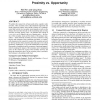Free Online Productivity Tools
i2Speak
i2Symbol
i2OCR
iTex2Img
iWeb2Print
iWeb2Shot
i2Type
iPdf2Split
iPdf2Merge
i2Bopomofo
i2Arabic
i2Style
i2Image
i2PDF
iLatex2Rtf
Sci2ools
MOBICOM
2009
ACM
2009
ACM
Connectivity of cognitive radio networks: proximity vs. opportunity
We address the connectivity of large-scale ad hoc cognitive radio networks, where secondary users exploit channels temporarily and locally unused by primary users and the existence of a communication link between two secondary users depends not only on the distance between them but also on the transmitting and receiving activities of nearby primary users. We introduce the concept of connectivity region defined as the set of density pairs — the density of the secondary users and the density of the primary transmitters — under which the secondary network is connected. Using theories and techniques from continuum percolation, we analytically characterize the connectivity region of the secondary network by showing its three basic properties and analyzing its two critical parameters. Furthermore, we reveal the tradeoff between proximity (the number of neighbors) and the occurrence of spectrum opportunities by studying the impact of the secondary users’ transmission power on the conn...
| Added | 28 May 2010 |
| Updated | 28 May 2010 |
| Type | Conference |
| Year | 2009 |
| Where | MOBICOM |
| Authors | Wei Ren, Qing Zhao, Ananthram Swami |
Comments (0)

